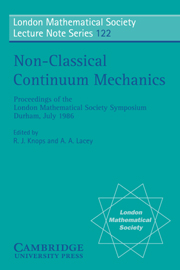 Non-Classical Continuum Mechanics
Non-Classical Continuum Mechanics Book contents
- Frontmatter
- FOREWORD
- Contents
- LIST OF PARTICIPANTS
- PART I PRINCIPAL LECTURES
- PART II SINGLE INVITED LECTURES
- Some Mathematical Problems Arising From the Oil Service Industry
- Randomly Diluted Inhomogeneous Elastic Networks near the Percolation Threshold
- Adaptive Anisotropy: An Example in Living Bone
- Stability of Elastic Crystals
- Optimal Bounds for Conduction in Two-Dimensional, Two-Phase, Anisotropic Media
- Rapid Flows of Granular Materials
- The Constrained Least Gradient Problem
- The Fusion of Physical and Continuum-Mechanical Concepts in the Formulation of Constitutive Relations for Elastic-Plastic Materials
- Singularities in Elliptic Non–Smooth Problems. Applications to Elasticity
- Solitons in Elastic Solids Exhibiting Phase Transitions
- On the Dynamics of Structural Phase Transitions in Shape Memory Alloy
- On the Homogenization of Some Free Boundary Problems
- The Point Interaction Approximation, Viscous Flow Through Porous Media, and Related Topics
Stability of Elastic Crystals
Published online by Cambridge University Press: 11 May 2010
- Frontmatter
- FOREWORD
- Contents
- LIST OF PARTICIPANTS
- PART I PRINCIPAL LECTURES
- PART II SINGLE INVITED LECTURES
- Some Mathematical Problems Arising From the Oil Service Industry
- Randomly Diluted Inhomogeneous Elastic Networks near the Percolation Threshold
- Adaptive Anisotropy: An Example in Living Bone
- Stability of Elastic Crystals
- Optimal Bounds for Conduction in Two-Dimensional, Two-Phase, Anisotropic Media
- Rapid Flows of Granular Materials
- The Constrained Least Gradient Problem
- The Fusion of Physical and Continuum-Mechanical Concepts in the Formulation of Constitutive Relations for Elastic-Plastic Materials
- Singularities in Elliptic Non–Smooth Problems. Applications to Elasticity
- Solitons in Elastic Solids Exhibiting Phase Transitions
- On the Dynamics of Structural Phase Transitions in Shape Memory Alloy
- On the Homogenization of Some Free Boundary Problems
- The Point Interaction Approximation, Viscous Flow Through Porous Media, and Related Topics
Summary
INTRODUCTION
Twinning, phase transitions and memory shape effects are frequently observed in solid materials with crystalline structure (cf. [3], [19]). As remarked by Wayman & Shimizu [19], it is of great theoretical and technological interest to investigate and predict the onset of such phenomena and to analyse equilibria and stability for this type of material.
The mathematical approach to these problems has recently been addressed by several authors, including Chipot & Kinderlehrer [4], Ericksen [7], [8], [9], Fonseca [10], [11], [12], Fonseca & Tartar [13], James [13], Kinderlehrer [15], Parry [17] and Pitteri [18], within the framework of a continuum theory based on nonlinear thermoelasticity proposed by Ericksen [7], [8]. The thermoelastic behaviour is quite noticeable in certain alloys for some ranges of temperature. As an example, Basinski & Christian [3] found that at room temperature Indium-Thallium alloys are perfectly plastic but for temperatures above 100°C or below 0°C they exhibit rubber like behaviour.
We summarize briefly the notion of an elastic crystal as described by Ericksen [9] and Kinderlehrer [15] (see also Ericksen [7], [8], and Fonseca [10]). In terms of molecular theory, a (pure) crystal is a countable set of identical atoms arranged in a periodic manner. By fixing a cartesian coordinate system with origin at one of the atoms and orthonormal basis [e1, e2, e3]l the position vectors of the atoms of the lattice relative to some choice of linearly independent lattice vectors {a1, a2, a3} may be given by where 114 mi ∈ Z, i =; 1, 2, 3, and A is the matrix with columns a1, a2, a3.
- Type
- Chapter
- Information
- Non-Classical Continuum MechanicsProceedings of the London Mathematical Society Symposium, Durham, July 1986, pp. 187 - 196Publisher: Cambridge University PressPrint publication year: 1987
- 2
- Cited by
